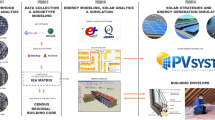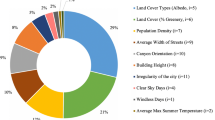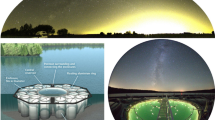Abstract
Architects, engineers and urban planners have today at their disposal several tools for simulating the energy yield of photovoltaic systems. These tools are based on mathematical models that perform repetitive calculations to determine the annual irradiation received by solar panels; hence when photovoltaic systems are installed in complex urban environments, the simulations become highly computationally demanding. Here we present a simplified and yet accurate model for the direct calculation of the annual irradiation and energy yield of photovoltaic systems in urban environments. Our model is based on the correlation between the solar radiation components and the shape of the skyline profile. We show how calculations can be simplified by quantifying the skyline using two indicators: the sky view factor and the sun coverage factor. Model performance is evaluated in different climates using measured data from different photovoltaic systems. Results indicate that the proposed model significantly reduces the required computation time while preserving a high estimation accuracy.
This is a preview of subscription content, access via your institution
Access options
Access Nature and 54 other Nature Portfolio journals
Get Nature+, our best-value online-access subscription
$29.99 / 30 days
cancel any time
Subscribe to this journal
Receive 12 digital issues and online access to articles
$119.00 per year
only $9.92 per issue
Buy this article
- Purchase on Springer Link
- Instant access to full article PDF
Prices may be subject to local taxes which are calculated during checkout






Similar content being viewed by others
Data availability
The data that support the plots within this paper and other findings of this study are available from the corresponding authors upon reasonable request.
References
World Urbanization Prospects: The 2014 Revision (United Nations Department of Economics and Social Affairs, Population Division, 2015).
Frankl, P., Nowak, S., Gutschner, M., Gnos, S. & Rinke, T. Technology Roadmap: Solar Photovoltaic Energy (International Energy Association, 2010).
Huld, T. et al. The Rooftop Potential for PV Systems in the European Union to deliver the Paris Agreement. European Energy Innovation Spring 2018, 12–15 (2018).
Gagnon, P., Margolis, R., Melius, J., Phillips, C. & Elmore, R. Rooftop Solar Photovoltaic Technical Potential in the United States. A Detailed Assessment Technical Report NREL/TP-6A20-65298 (National Renewable Energy Lab, 2016).
Ballif, C., Perret-Aebi, L.-E., Lufkin, S. & Rey, E. Integrated thinking for photovoltaics in buildings. Nat. Energy 3, 438–442 (2018).
Redweik, P., Catita, C. & Brito, M. Solar energy potential on roofs and facades in an urban landscape. Sol. Energy 97, 332–341 (2013).
Anderson, K. H., Coddington, M. H. & Kroposki, B. D. Assessing technical potential for city PV deployment using NREL’s In My Backyard tool. In IEEE 35th Photovoltaic Specialists Conference (PVSC) 001 085–001 090 (IEEE, 2010); https://doi.org/10.1109/PVSC.2010.5614697
Espeche, J. M., Noris, F., Lennard, Z., Challet, S. & Machado, M. PVSITES: building-integrated photovoltaic technologies and systems for large-scale market deployment. Proceedings 1, 690 (2017).
Compagnon, R. Solar and daylight availability in the urban fabric. Energy Build. 36, 321–328 (2004).
Lagios, K., Niemasz, J. & Reinhart, C. F. Animated building performance simulation (ABPS)-linking Rhinoceros/Grasshopper with Radiance/Daysim. In 4th National Conference of IBPSA-USA SimBuild 2010 321–327 (IBPSA-USA, 2010).
Kämpf, J. H., Montavon, M., Bunyesc, J., Bolliger, R. & Robinson, D. Optimisation of buildings’ solar irradiation availability. Sol. Energy 84, 596–603 (2010).
Brito, M. C., Gomes, N., Santos, T. & Tenedório, J. A. Photovoltaic potential in a Lisbon suburb using lidar data. Sol. Energy 86, 283–288 (2012).
Agugiaro, G. et al. Solar radiation estimation on building roofs and web-based solar cadastre. ISPRS Ann. Photogram. Remote Sens. Spatial Inf. Sci. I-2, 177–182 (2012).
Freitas, S., Catita, C., Redweik, P. & Brito, M. C. Modelling solar potential in the urban environment: state-of-the-art review. Renew. Sustain. Energy Rev. 41, 915–931 (2015).
Lindberg, F., Jonsson, P., Honjo, T. & Wästberg, D. Solar energy on building envelopes—3D modelling in a 2D environment. Solar Energy 115, 369–378 (2015).
Carneiro, C. et al. Urban environment quality indicators: application to solar radiation and morphological analysis on built area. In Proc. 3rd WSEAS International Conference on Visualization, Imaging and Simulation 141–148 (WSEAS, 2010).
Jakubiec, J. A. & Reinhart, C. F. Towards validated urban photovoltaic potential and solar radiation maps based on LiDAR measurements, GIS data, and hourly DAYSIM simulations. In Proc. 5th National Conference of IBPSA-USA SimBuild 2012 628–637 (IBPSA, 2012).
Robinson, D. Urban morphology and indicators of radiation availability. Sol. Energy 80, 1643–1648 (2006).
Rodrguez, L. R., Duminil, E., Ramos, J. S. & Eicker, U. Assessment of the photovoltaic potential at urban level based on 3d city models: A case study and new methodological approach. Sol. Energy 146, 264–275 (2017).
Davies, J. & Hay, J. Calculation of the solar radiation incident on an inclined surface. In Proc. First Canadian Solar Radiation Data Workshop 59–72 (Supply and Services Canada, 1978).
Chatzipoulka, C., Compagnon, R., Kaempf, J. & Nikolopoulou, M. Sky view factor as predictor of solar availability on building façades. Sol. Energy 170, 1026–1038 (2018).
Reindl, D., Beckman, W. & Duffie, J. Evaluation of hourly tilted surface radiation models. Sol. Energy 45, 9–17 (1990).
Smets, A. H. et al. Solar Energy: The Physics and Engineering of Photovoltaic Conversion Technologies and Systems. (UIT Cambridge, Cambridge, 2016).
Perez, R., Seals, R., Ineichen, P., Stewart, R. & Menicucci, D. A new simplified version of the Perez diffuse irradiance model for tilted surfaces. Sol. Energy 39, 221–231 (1987).
Ineichen, P., Perez, R. & Seals, R. The importance of correct albedo determination for adequately modeling energy received by tilted surfaces. Sol. Energy 39, 301–305 (1987).
Steyn, D. The calculation of view factors from fisheye-lens photographs: research note. Atmos. Ocean 18, 254–258 (1980).
Johnson, G. T. & Watson, I. D. The determination of view-factors in urban canyons. J. Clim. Appl. Meteorol. 23, 329–335 (1984).
Perez, R., Ineichen, P., Seals, R., Michalsky, J. & Stewart, R. Modeling daylight availability and irradiance components from direct and global irradiance. Sol. Energy 44, 271–289 (1990).
Blanco-Muriel, M., Alarcón-Padilla, D. C., López-Moratalla, T. & Lara-Coira, M. Computing the solar vector. Solar Energy 70, 431–441 (2001).
Meteonorm Handbook Part I: Software version 7.2 (Meteotest, Bern, 2017).
Carr, A. & Pryor, T. A comparison of the performance of different PV module types in temperate climates. Sol. Energy 76, 285–294 (2004).
Actueel Hoogtebestand Nederland (AHN, accessed 2 May 2018); http://www.ahn.nl/common-nlm/contactahn.html
Marion, B., et al. Performance parameters for grid-connected PV systems. In Conference Record of the 31st IEEE Photovoltaic Specialists Conference 1601–1606 (IEEE, 2005); https://doi.org/10.1109/PVSC.2005.1488451.
PVOutput (PVOutput, 2013); http://www.pvoutput.org/
Monthly Mean Daily Global Solar Exposure (Australian Government Bureau of Meteorology, accessed 7 October 2018); http://www.bom.gov.au/jsp/ncc/cdio/weatherData/av?p_nccObsCode=203&p_display_type=dataFile&p_startYear=&p_c=&p_stn_num=023119
Gál, T., Lindberg, F. & Unger, J. Computing continuous sky view factors using 3d urban raster and vector databases: comparison and application to urban climate. Theor. Appl. Climatol. 95, 111–123 (2009).
An, S. et al. Three-dimensional point cloud based sky view factor analysis in complex urban settings. Int. J. Climatol. 34, 2685–2701 (2014).
Kanters, J. & Horvat, M. Solar energy as a design parameter in urban planning. Energy Procedia 30, 1143–1152 (2012).
Amado, M. & Poggi, F. Solar urban planning: a parametric approach. Energy Procedia 48, 1539–1548 (2014).
De Luca, F. Solar form finding. subtractive solar envelope and integrated solar collection computational method for high-rise buildings in urban environments. In Proc. 37th Annual Conference of the Association for Computer Aided Design in Architechture (eds Nagakura, T. et al.) 212–221 (2017).
Demain, C., Journée, M. & Bertrand, C. Evaluation of different models to estimate the global solar radiation on inclined surfaces. Renew. Energy 50, 710–721 (2013).
Fuentes, M. K. A Simplified Thermal Model for Flat-plate Photovoltaic Arrays Technical Report SAND85-0330-UC-63, 5 (Sandia National Labs, 1987).
Xiao, W., Dunford, W. G. & Capel, A. A novel modeling method for photovoltaic cells. In IEEE 35th Annual Power Electronics Specialists Conference (PESC 04) Vol. 3, 1950–1956 (IEEE, 2004); https://doi.org/10.1109/PESC.2004.1355416.
Lasnier, F. & Ang, T. G. Photovoltaic Engineering Handbook (Adam Hilger, New York, 1990).
Jain, A. & Kapoor, A. A new method to determine the diode ideality factor of real solar cell using Lambert w-function. Sol. Energy Mater. Sol. Cells 85, 391–396 (2005).
Meteonorm Handbook Part II: Theory version 7.2 (Meteotest, Bern, 2017).
Acknowledgements
We thank the Dutch company Solar Monkey (www.solarmonkey.nl) for providing skyline profiles and annual AC yield measurements of PV systems monitored in the Netherlands for the validation of our model.
Author information
Authors and Affiliations
Contributions
A.C., O.I. and M.Z. conceived the research. A.C. worked on modelling and the validation analysis. H.Z. and O.I. helped with the analysis and validations. O.I. and M.Z. supervised the whole project. All authors discussed the results and contributed to the writing of the paper.
Corresponding author
Ethics declarations
Competing interests
The authors declare no competing interests.
Additional information
Publisher’s note: Springer Nature remains neutral with regard to jurisdictional claims in published maps and institutional affiliations.
Supplementary information
Supplementary Information
Supplementary Notes 1–2, Supplementary Figures 1–6, Supplementary Tables 1–7, Supplementary References
Rights and permissions
About this article
Cite this article
Calcabrini, A., Ziar, H., Isabella, O. et al. A simplified skyline-based method for estimating the annual solar energy potential in urban environments. Nat Energy 4, 206–215 (2019). https://doi.org/10.1038/s41560-018-0318-6
Received:
Accepted:
Published:
Issue Date:
DOI: https://doi.org/10.1038/s41560-018-0318-6
This article is cited by
-
Instant solar irradiation forecasting for solar power plants using different ANN algorithms and network models
Electrical Engineering (2023)
-
Evaluating Urban Geometry Impacts on Incident Solar Radiation on Building Envelopes
Environmental Modeling & Assessment (2021)
-
Prediction improvement of potential PV production pattern, imagery satellite-based
Scientific Reports (2020)
-
A high-efficiency bioinspired photoelectric-electromechanical integrated nanogenerator
Nature Communications (2020)



